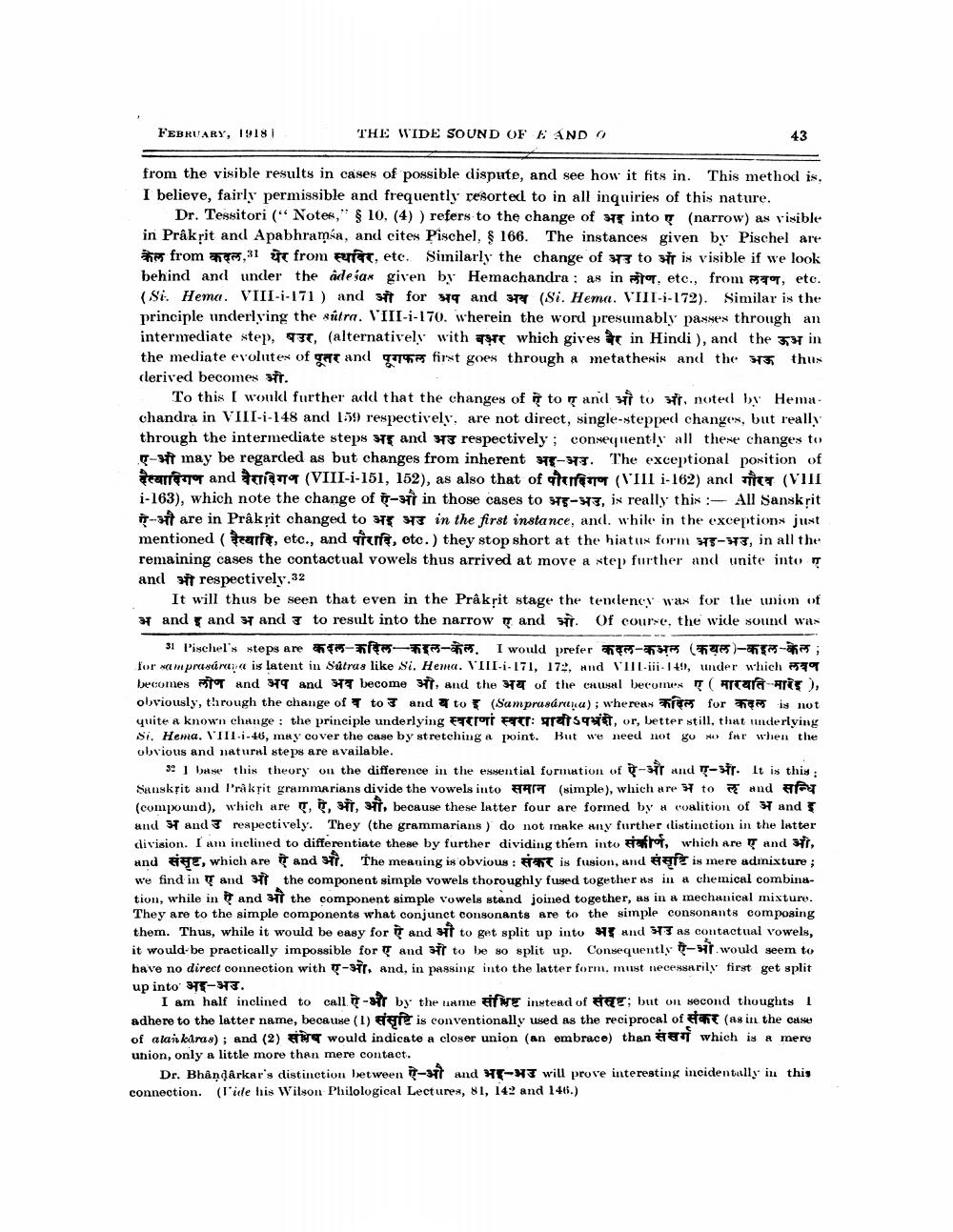________________
FEBRUARY, 1918
THE WIDE SOUND OF EANDO
43
from the visible results in cases of possible dispute, and see how it fits in. This method is. I believe, fairly permissible and frequently resorted to in all inquiries of this nature.
Dr. Tessitori ("* Notes," $ 10, (4) ) refers to the change of 7 into (narrow) as visible in Prakrit and Apabhrama, and cites Pischel, § 166. The instances given by Pischel are केल from कदल,1 घेर from स्थविर, etc. Similarly the change of अर to t is visible if we look behind and under the adesas given by Hemachandra: as in IT, etc., from TT, etc. (Si. Hema. VIII-i-171 ) and sit for 19 and 7 (Si. Hema. VIII-1-172). Similar is the principle underlying the shtra. VIII-:-170. wherein the word presumably passes through an intermediate step, 93T, (alternatively with T which gives er in Hindi ), and the in the mediate evolutes of gate and first goes through a metathesis and the 13 thus clerived becomes it.
To this I would further add that the changes of it to T and wito ft. noted by Hemachandra in VIII-i-148 and 1.59 respectively, are not direct, single-stepped changes, but really through the intermediate steps 78 and 3 respectively; consequently all these changes to ए-भी may be regarded as but changes from inherent अर-अउ. The exceptional position of दैत्यादिगण and वैरादिगण (VIII-i-151, 152), as also that of पौरादिगण (VIII i-162) and गौरव (VIII i-163), which note the change of - in those cases to 93-93, in really this :- All Sanskrit IT-aft are in Prakrit changed to STK in the first instance, and, while in the exceptions just mentioned turf, etc., and herf, etc.) they stop short at the hiatus form 93-93, in all the remaining cases the contactual vowels thus arrived at move a step further and unite into and it respectively.32
It will thus be seen that even in the Prakrit stage the tendency wax for the union of 37 and and and to result into the narrow T and sil. Of course, the wide sound was
31 lischel's Nteps are - - - . I would prefer - (yes)- - ; for nam pravúrty is latent in Sätras like Si. Hema. VIII-i-171, 17., and VII - I 49, under which 1577 becomes लोण and अप and अव become ओ, and the अय of the causal becomm.s ए (मारयति-मारेड), obviously, through the change of 7 to 3 and to (Samprasária); whereas Pireas for any is not quite a known change the principle underlying ETCIT FITT: gratis , or, better still, that underlying Si. Hema. VIII.-46, may cover the case by stretching a joint. But we need not g o for when the obvious and natural steps are available.
39] be this theory on the difference in the essential formation of sir and T-Str. It is this: Sanskțit and I'råkpit grammarians divide the vowels into #67 (simple), which are to and af (compound), which are T, T, TT, TT, because these latter four are formed by a coalition of and and 9 and 3 respectively. They (the grammarians) do not make any further distinction in the latter division. I am inclined to differentiate these by further dividing them into F r , which are T and fi, und E, which are and . The meaning is obvious: is fusion, and eft is mere adinixture; we find in and off the component simple vowels thoroughly fused together as in a chemical combination, while in and the component simple vowels stand joined together, as in a mechanical mixture. They are to the simple components what conjunct consonants are to the simple consonants composing them. Thus, while it would be easy for it and it to get split up into 973 and 73 as contactual vowels, it would be practically impossible for T and Ti to be so split up. Consequently 1- 1. would seem to have no direct connection with T-ST. And, in passing into the latter form, must necessarily first get split up into 37-973.
I am half inclined to call it sit by the name NE instead of ETE; but on second thoughts 1 adhere to the latter name, because (1) Bigle is conventionally used as the reciprocal of taie (as in the cast of alan kinas); and (2) i would indicate a closer union (an embrace) than aT which is a mere union, only a little more than mere contact.
Dr. Bhandarkar's distinction between 1 and HE-H3 will prove interesting incidentally in this connection. (l'ide his Wilson Philological Lectures, I, 142 and 146.)




